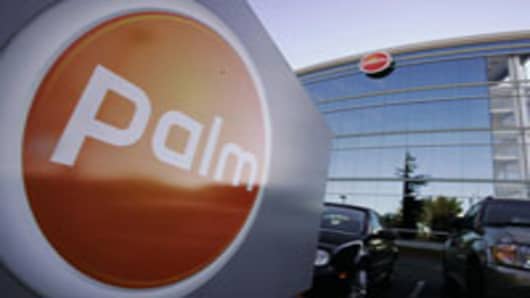The news Thursday from Palm will be bad.
We know that because the company pre-announced its earnings a few weeks ago. The company's credibility problem from both a marketplace and managerial perspective is serious; and investors who enjoyed a blockbuster run in 2009 seem to be running for the exits in 2010.
And now it seems Wall Street is beginning to pile on.
Peter Misek, the wireless analyst at Canaccord Adams who nailed Palm's latest problems with a note on February 24, just a day before Palm issued its earnings warning, is at it again with a dire report Tuesday detailing new and troubling issues facing this company. He's cutting estimates again thanks to information he's received that Palm's potential relationship with AT&T is souring. He says the carrier has delayed the launch of the Palm Pre and Palm Pixi from April to mid-Summer, and says a "long list of technical issues" with the phones is leading AT&T to "sharply reduce its marketing budget for the launch."
AT&T is arguably the lynchpin in any kind of Palm turnaround.
Palmdesperately needs AT&T for marketing and distribution. Desperately. Trouble with this relationship, following a complete halt in new orders from existing partners like Sprint, Verizon and others, spells big-time problems for this company. Misek is cutting his unit forecast from 720,000 to 670,000 for the February quarter, and a new average selling price of $345, down from $351. For Fiscal 2011, he sees 3.58 million units sold, down from the 4 million he originally anticipated. Fiscal 2011 revenue drops to $1.2 billion from $1.35 billion and his EPS projection now sits at a $1.16 a share loss. He originally expected a loss of 96 cents.
Incidentally, Palm announced in February that third quarter revenue will be in the range of $300 million to $320 million on a non-GAAP basis, way below the Street consensus at the time of $424.7 million. That was good for a 20 percent plunge in Palm shares, and they've been in steady decline ever since.
Consensus now for Palm's report on Thursday is a loss of 43 cents a share on $306.7 million. Palm doesn't offer guidance, but you can bet there will be a colorful question and answer session from analysts looking for any metrics by which to measure the company's ongoing prospects. There are even murmurs about how long CEO Jon Rubinstein can expect to preside over the company in its current form.
I have detailed Palm's ongoing issues here before.
The company's production stoppage in China originally attributed to the Chinese New Year lasted for the balance of February, and not the traditional week that might be typical of a holiday shutdown. Then, when production actually resumed -- which could have been seen as an incremental positive to the company's stock, Palm never issued a formal statement as such, even though the company had only weeks before confirmed that production had actually stopped. The company has a bizarre strategy of leaking material news not on its corporate website, but on the personal Twitter account and blog of its corporate communications vice president.
The whole thing just seems weird.
There are some analysts on the Street who think Palm might be a good, long-term opportunity. But technical and marketing missteps might prevent those opportunities from ever coming to fruition. Truth be told, if Palm were operating in a vacuum of some kind, it might stand some kind of chance. It just so happens that Palm is trying to compete in the single most competitive and dynamic sector in all of tech. Huge companies with deep pockets (like Laurentian Abyss-deep in the form of Apple and Google and Research in Motion and others) are pulling out all the stops not just to protect their market share but grow it. Palm is precariously perched on a rickety raft while an angry sea swells beneath it. Those rising waters are floating a lot of boats, but they threaten to sink Palm.
Palm has become the center of increasing takeover speculation: With Palm on a steep ascent through much of last year, companies that might have been interested in an acquisition, such as Dell, were seen as having missed their opportunity. Since then, Palm's market cap has been slashed by two-thirds, and now sits at around $870 million. The company's handsets are slick, its WebOS software has gotten very good reviews. With Google's Android Operating System continuing to enjoy market penetration (Google CEO Eric Schmidt says carriers are selling 60,000 Android units a day), Apple and RIM still coming on strong, a market alternative in the form of a Palm's WebOS might be compelling for someone. I've made the case for Motorola, but Hewlett-Packard could make sense as well.
Palm's days as a standalone company seem numbered.
Palm's days as a company at all might be numbered. And that's truly unfortunate. This might be locker-room material and maybe a year from now, with Palm above $16 (where it was last October), or folded into another company at a sweet premium, I'll look back on this post and happily admit how wrong I was. I hope for Palm shareholders that's the case. But sometimes, good technology simply isn't good enough. We've seen it so many times in Silicon Valley before. We may be seeing it again.


